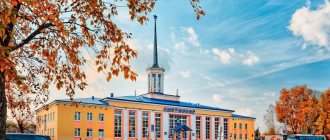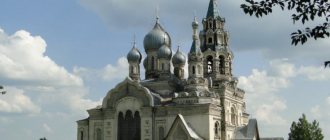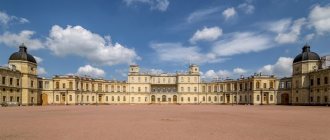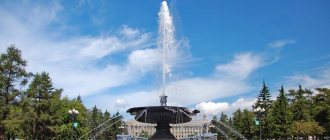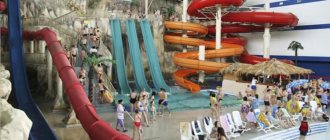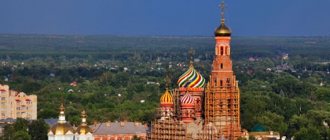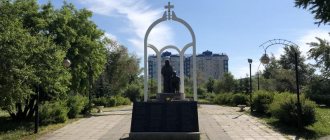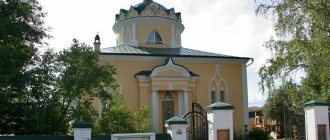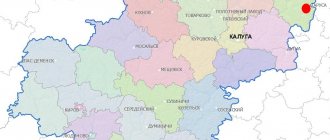When you only have a couple of days to explore the city, you want to make the most of your time and see all the most interesting sights . Here, of course, everyone has different needs - some are interested in museums, while others are interested in unusual cafes.
We spent 2 days in Yekaterinburg and fell in love with the city at first sight! On the one hand, this is a city with a population of one million, that is, it is not so small, but on the other hand, it is very cozy, and it seems that you can walk everywhere.
So, what to see in Yekaterinburg in a couple of days?
Red line
This walking route to the main attractions of the city seemed like a great idea! And why aren’t there such people in all cities? The red line runs through the center and is intended for independent exploration of the city . The length of the route is 6.5 km, and it is circular - that is, it returns to the starting point, which is very convenient.
The most interesting sights are marked on the asphalt with numbers - there are 35 of them. And on the official website of the Red Line you can learn about the history of Yekaterinburg in Russian and English.
Stories, routes and tourist tips
When planning a trip to Yekaterinburg, we advise you to get acquainted with the stories of tourists who have already visited the city. Perhaps you will like their routes, or you will find something useful there that will come in handy on your travels.
We recommend watching:
- Routes in the general Guide to Yekaterinburg.
- Route along the “Red Line”: part 1, part 2.
- Route along the Blue Line of Yekaterinburg.
- Sightseeing two-day route from Maria Penina “Ekaterinburg - a city of contrasts.”
All reviews about the trip to Ekaterinburg on Turister.Ru
Don’t forget also that the site has a “Questions and Answers” , where you can, if necessary, check with experts for up-to-date information on city attractions or simply get advice on issues related to a trip to Yekaterinburg.
Lampshades on Lenin Avenue Photo: © Anna Kudryavtseva
Sevastyanov's House
This building is impossible to miss; it stands out from the rest of the city's architecture. It’s hard to call this work of art a home, it’s more like a palace ! The handsome mansion has seen several generations of owners, but the building was first mentioned in 1817 and since then it has been changed, rebuilt and restored more than once.
When the collegiate assessor and owner of the house Nikolai Ivanovich Sevastyanov left Yekaterinburg, the house went to the treasury and until 1917 the Yekaterinburg District Court . During the revolutionary years, Sevastyanov’s house was heavily destroyed and looted, and then became the location of the trade union council . In 2008, the Sevastyanov House was restored and transferred to the residence of the President of the Russian Federation .
Very unusual facade color
Square 1905 (Central Square of Yekaterinburg)
Speaking about what to see in Yekaterinburg, it is worth mentioning that it is most convenient to start seeing the city and its center from here. The square of 1905 was renamed more than once (Church and Cathedral, Trade, Main Trade), and initially consisted of two different squares. In 1905, the first rally and political demonstration took place here, which turned into a massacre.
Like every main square of the city, the central square of Yekaterinburg has seen a lot of events. took place here in 1917 , soldiers left the square for the front, people were buried right there, and since 1994 the metro station “Ploshchad 1905” .
Observation deck of the Vysotsky business center
A great way to see Yekaterinburg from a bird's eye , especially if you only have 1-2 days . The observation deck is located on the 52nd floor of the business center at an altitude of 186 meters! The site is located in the open air and is fenced with durable glass, so excellent photos . And for those who want to drink coffee or champagne on a skyscraper, there are small rooms with excellent views of the city .
The best view of Yekaterinburg!
What to see in Yekaterinburg in 1-2 days? Walking route
From time to time, fate and work take me to new places in our vastness. This is exactly what happened with Yekaterinburg - a short business trip and a busy work schedule, but I still managed to get to know the capital of the Urals a little. I really liked the city! I will be happy to share locations, attractions and restaurants where we were deliciously fed.
Spoiler: Yekaterinburg is a cool city for a weekend trip. Highly recommend!
Yekaterinburg is a young, dynamic, slightly daring city and is not at all like my Nizhny Novgorod. NiNo is a kind of grandpa with a story... unhurried and specific. And Ekat is fast, tasty, stylish. The mood is more like Moscow than St. Petersburg.
The Vysotsky skyscraper and the wooden houses next door in the very center of the city surprised at first, but then the eye got used to it. The capital of the Urals is completely eclectic in architecture. I couldn’t get away from the unusual signs on shops and cafes. Everything is done with some zest and enthusiasm.
When walking around Yekaterinburg, be sure to watch your step. Firstly, then definitely don’t miss the fashionable sewer manholes “Ekat-Erin-Burg” from the Made in Ural creative community. You will see this logo everywhere in the city and don’t be fooled by the fact that there are burger joints at every turn (I thought so at first). And secondly, in the capital of the Urals there is a pedestrian ring route through the historical center of the city. The red route lines are painted directly on the asphalt.
- Temple on blood. Place where the Romanov royal family was executed. There is a museum nearby
- Skyscraper "Vysotsky" with a 360-degree observation deck and the Vysotsky Museum on the 1st floor
- Yeltsin Center
- Sevastyanov's House
- Dam and park nearby
- Water tower with museum
- Literary Quarter (near the Church on the Blood)
- Monument to the Beatles and keyboard on the embankment of the Iset River
- Vayner Street (local Arbat). I was not impressed, Bolshaya Pokrovskaya is somehow nicer))
- Modern Art Museum. There is a curious cast-iron pavilion there
My walk turned out to be spontaneous; I did not prepare for it at all and did not look for information about the sights of Yekaterinburg. If you only have 1.5-2 hours of time in the evening, take a closer look at my route. We start from the Greenwich shopping center through the Arboretum along the Iset River embankment and then follow the map (green marks).
The small arboretum park was especially picturesque in the fall. We pass through it towards Iset. If you bring some bread with you in advance, you can feed the ducks.
There is a bridge across the river, and right in front of us is the “Copper House” - the headquarters of the Russian Copper Company for 12 billion dollars)). This is the first building built in Russia by the famous architect Norman Foster. The office building has 15 floors and 184 modules, which were assembled separately and installed on site.
There's a whole article on The Village about the Copper House, google it if you're interested. I especially liked two facts: 1) the architects observed sunrises and sunsets in Yekaterinburg when they designed the edges of the building so that the facade would be golden brown at different times of the day; 2) for the external façade, a special shade of paint was selected, as similar as possible to copper. This is how I understand the approach to things!
From the bridge there is a view of the Yekaterinburg Circus. Agree that the building with the air dome looks unusual. This is the whole of Yekaterinburg)). Curious and not at all pretentious.
And we move further along the Iset River along the embankment. Before us is the first art object - a monument to the keyboard. The most interesting thing is that I wasn’t specifically looking for a keyboard. I was looking on the Internet for options for attractions in Ekata before a business trip and my eyes caught an unusual art object. I understood that I would have little time, so I didn’t even hope to find her.
The creative monument introduced a certain cultural note into the appearance of the city. For example, the river is now jokingly called the I-net)). And some craftsmen use buttons as a souvenir. By the way, they are concrete and quite massive.
The second art object on my route is dedicated to the Beatles. You can see exactly where it is located on the map attached above.
This concludes my short evening walk route. The final point is Vysotsky. The 54-story skyscraper is the calling card of the city. Essentially it is a business center with offices, hotels and restaurants. Having an office in Vysotsky is very status-worthy)).
The open observation deck is located at an altitude of 186 meters. It's best to go up here at sunset. A gorgeous 360-degree panorama of the city and beautiful photographs are guaranteed.
The entrance ticket costs 400 rubles. There are discounts for schoolchildren, students, pensioners and other categories of citizens. More details at the link. Please note that only cash payment is possible. The price of the observation ticket includes free entry to the Vysotsky Museum. Be sure to check out the museum. Very worthy and interesting.
The museum has recreated the interiors of a Moscow apartment and a room in a hotel in Sverdlovsk, where Vladimir Semenovich lived. Many of Vysotsky’s personal belongings and movie props are on display as exhibits. The Mercedes and the green front door are especially eye-catching. Be sure to look through the peephole)).
If you have more free time, I suggest continuing the walk and reaching the famous Plotinka.
I had a clear goal - to visit the Yeltsin Center. I had heard too much about him, and my colleagues desperately advised me.
What is the Yeltsin Center? Externally, it is a building of an unusual shape with lighting that constantly changes color. Internally, there is a serious cultural component of the city.
The official website of the Yeltsin Center is https://yeltsin.ru. Before traveling to Yekaterinburg, check the poster in case some interesting event is planned for your dates.
I didn’t go to the Yeltsin Museum, but I spent a long time in the local souvenir shop. Perhaps the Yeltsin Center has one of the best souvenir shops I have ever seen. There are no banal magnets here, but there are T-shirts with funny inscriptions “I’m from the Urals,” dried pine cones, local chocolate, postcards and much more. In short, you can only buy souvenirs “from the Urals” here.
The Yeltsin Center is located on the banks of the City Pond, formed by the dam of the Iset River. Picturesque views and a pleasant walk are guaranteed if you decide to walk to Plotinka. It's only 15-20 minutes along the embankment. How beautiful autumn is in the capital of the Urals!
Don't miss the Sevastyanov House on Lenin Avenue 35. The exterior decor of the building is bright and original, you are unlikely to pass by, but suddenly))
The architectural monument and cultural heritage site is known as “the only example of neo-Gothic architecture that has no analogues in the Urals.” N.I. Sevastyanov acquired an already constructed building in the classical style and very boldly reconstructed it in 1866.
Well, before us is, perhaps, the most important attraction of Yekaterinburg - Plotinka. It was from here that the history of the city began in 1723.
The dam can be called a city-forming structure. It provided energy for the Yekaterinburg plant. Well, then a city grew around it. An interesting fact is that a unique type of larch was used to build the dam. When it came into contact with water, it did not deteriorate, but rather turned to stone.
I didn't have enough time to walk around the city. For example, I never went to the Church on the Blood. The topic of museums and theaters in Yekaterinburg also remained unsolved.
If you have little time for the capital of the Urals, look at the options for organized excursions. For example - Daily walk around Yekaterinburg. or Explore Yekaterinburg in 3 hours for only 520 rubles.
We lived in the Park Inn by Radisson 4* chain. A good hotel option in the city center with a clear level of service. The buffet breakfast was pleasant. Despite the pandemic and some restrictions, I have no questions about Park Inn.
Below is my selection of hotels with a good price-quality ratio:
Voznesensky Hotel 4* - the score of 9 points on Booking speaks for itself. Excellent location of the hotel, delicious breakfasts, cozy rooms from 4,000 rubles for two per night.
Central by USTA Hotels 3* is a hotel with a classic interior of rooms, convenient location for walking around the city. Almost 1000 reviews with a rating of 8.5. Room rates from 3,800 rubles.
I can’t pass by the Vysotsky Hotel. Damn expensive. From 7500 rubles per day per room. But the room price includes a luxurious breakfast and panoramic views 24/7. And you don’t have to pay to enter the observation deck))).
In the price segment of about 3,000 rubles per day, I suggest considering apartments.
Allen Park in Radius - in this option, a family studio room costs 2,800 rubles. Booking score 9.5 points!
Here is another stylish apartment in the very center of the city for 2,700 rubles per day - RADIUS Central House Apart-hotel. When we travel as a family, we most often choose apartments.
If you expand your search on the Booking map and look for accommodation not on the “red line”, you can book a decent hotel for 2-2.5 thousand rubles per day. And a stylish hostel generally costs 400-500 rubles. Look at what a great option - Roomy Hostel! I would love to live in something like this.
The city has a lot of decent cafes, restaurants and coffee shops for every taste and budget. Before your trip, look through restaurant reviews on Tripadvisor and add options to your offline maps.
In this article I will only tell you about those establishments where I have been personally and can recommend them.
“Forks and Spoons” - have an inexpensive lunch
This is a chain of fast food cafes throughout the Urals with very decent homemade food. Despite the distribution area “a la” canteen, the interior of the cafe is attractive, it’s clean inside and I didn’t see any marginalized people there))).
Cafe addresses, detailed menu and prices are on the website - https://vilka-lozhka.com
"Own company"
This is a whole chain of restaurants. In addition to Yekaterinburg, they are present in Ufa, Chelyabinsk, Barnaul and other cities. See the link below for addresses. My colleagues and I stopped by Our Company for lunch during a trip to Nizhny Tagil. I absolutely liked the food. The set lunch is varied (at least three options for soup, salad and main course), and is served quickly. To help you understand the prices and choice of dishes, I am attaching a collage from the menu.
Restaurant chain website - https://svoya-kompaniya.ru
"Ratatouille"
We had dinner at this restaurant. The atmosphere is pleasant and the food is delicious. Prices are average. I tried the Wood Grouse Nest salad, grilled vegetables (grilled salad) and chkmeruli (spicy), a glass of wine after a hard day and delicious tea)). I recommend Ratatouille with pleasure.
Address: 72 Vostochnaya Street. There is one entrance and one menu for two restaurants “Ratatouille” and “Badrijani”.
"Ojakh"
If you are a fan of barbecue, grilled dishes, and meat in any form in general, then check out Odzhakh. I only tasted lula kebab, with vegetables as a side dish. The restaurant has private areas and a large common room.
Address: st. Malysheva 12B.
My favorite aggregator Tripster has more than 45 excursions in the city and beyond. I’ll just give you a tip on the most interesting options:
Dungeons of Yekaterinburg (650 rubles) - not every city has catacombs suitable for a “walk”. Only adults are invited to this three-hour entertaining excursion.
Criminal Yoburg (4000 rubles) - children of the 90s, this excursion is for you)). In Yekaterinburg, even now, in some places you can feel the feeling of the cult TV series “Brigada”. Just look at the Uralmash region.
Mysterious Yekaterinburg: in the footsteps of traditions and legends (2600 rubles) - I love excursions with an element of some mystery.
Street art, gastronomic master classes, photo walks, immersion in architecture and culture - it seems to me that there are excursions in Yekaterinburg for every taste and budget. It’s also a great way to have fun and diversify your trip.
Until new meetings and impressions,
Oksana
On Instagram I'm @oxanazolot
Temple on blood
One of the main attractions to see in Yekaterinburg is the Church on the Blood. Nicholas II was shot along with his family and servants in 1918. The temple is two-level, with five domes, built in the Russian-Byzantine style. Orthodox pilgrims come here not only from Russia, but from abroad.
What to see in Yekaterinburg in 2 days: 9 best attractions
First day
With two full days to spare, you can take your time and tailor your route to suit your interests. If you are in the city for the first time, you should use the first day to get acquainted with the city's attractions. You can do it simply: take the Red Line , which connects 35 main attractions of Yekaterinburg. If you are interested in places associated with the name of the family of the last Russian emperor, follow the Blue Line . Over a significant area, these lines run parallel.
If you are ready to see the maximum amount of interesting things in the Ural capital on the first day, you will find the following material useful:
Detailed advice on what to see in Yekaterinburg in 1 day
Historical square
You should start getting acquainted with the city from the Historical Square, because this is where Yekaterinburg began. Local residents affectionately call the Historical Square “Plotinka” . Here stood a plant built in the first quarter of the 18th century by order of Emperor Peter I, and the plant began with a dam that blocked the Iset River to create a pond that provided it with water. The plant laid the foundation for the city, which dates back to 1723. Plotinka is the heart of Yekaterinburg; many important city events take place here. The dam continues to function today. Stop at the rhodonite stone, look at the seething water falling through the dam, because in the body of this dam there are still larch trunks laid in those historical times.
Don’t rush to leave, there are many interesting details in the park that are worth paying attention to. For example, the bas-relief “Birth of the City” depicts Vasily Tatishchev signing a decree on the creation of a plant. To the left is on the wall where the masonry of the first one has been preserved, and on the metal plates there is a plan of the plant-fortress and a story about the beginning of construction. Nearby is an alley along which lie large boulders, examples of the most famous Ural rocks.
Each building of the Historical Square is a historical monument; they now house museums. Depending on your interests, you can choose one of them: Museum of Nature , Museum of Fine Arts , Museum of Architecture and Design . There is also a small museum “Water Tower on Plotinka” , the exhibition of which is dedicated to the history of Plotinka and the inhabitants of the tower, built in 1890. After all, for two decades this tower was a two-flat residential building.
Read more: Historical park in Yekaterinburg
The dam of the City Pond and the bas-relief “Birth of the City” Photo: © Anna Kudryavtseva
City pond
Along the transition from the Historical Square, go to the other side of the Dam to the City Pond . By the way, this passage is also a kind of landmark of Yekaterinburg - there is a wall in memory of Viktor Tsoi .
The pond is a favorite place for the townspeople; it has existed in Yekaterinburg since 1723, since ponds along with dams were created during the construction of Ural factories as a source of energy. Since the founding of the city, the most eminent residents of the city have built houses on the embankment. On one side of the pond, nearby there are two objects of the “Red Line”, architectural monuments of Yekaterinburg - the famous Sevastyanov House and the Tarasov Estate , where the Residence of the Governor of the Sverdlovsk Region is located.
Estate of Savva Tarasov and House of N.I. Sevastyanov Photo: © Anna Kudryavtseva
Embankment of Working Youth
We will walk along the opposite bank of the City Pond - the embankment of Working Youth . Two of the most beautiful houses, built in the first half of the 19th century according to the design of the famous Ural architect M. P. Malakhov, have been preserved here:
- The house of the merchant I. G. Pshenichnikov , which now houses the Reception Room of the President of the Russian Federation in the Ural Federal District.
- House of the Chief Mining Chief , in which in 1837-1856. lived the chief head of the mining factories of the Ural Range, General V. A. Glinka. The Decembrists visited here, the future Emperor Alexander II stayed here with his teacher, poet V.A. Zhukovsky, and now it’s a hospital.
Further behind the square, so popular in 2019 news programs on central television channels, you can see the administrative buildings of the government of the Sverdlovsk region, the Sverdlovsk State Academic Drama Theater and the high-rise buildings of Yekaterinburg City.
House of merchant I.G. Pshenichnikova, architect M.P. Malakhov Photo: © Anna Kudryavtseva
Ekaterinburg City
Walking further along the embankment, you can see the most modern buildings of Yekaterinburg, built in the 21st century - the Demidov Business House, the Hayatt Hotel, the Iset Tower, the Yeltsin Center.
The Iset Tower, 212.8 meters high at crown level, is the tallest building in the country beyond the Urals. This is a residential building, don’t look for an observation deck there; for views from above, go to the Vysotsky skyscraper . On the ground floor of the tower there is a restaurant “Cow” , the basis of which is meat dishes. Reviews from visitors about the restaurant are mostly positive.
For orientation on the gastronomic expanses of the city, more information is in the material The best cafes and restaurants of Ekaterinburg
Ekaterinburg City Photo: © Anna Kudryavtseva
Yeltsin Center
This cultural, educational and educational complex was opened in 2015. The Boris Yeltsin Museum located there still causes controversy, and the reviews of those who visited it are diametrically opposed. Maybe you should go in and form your own opinion? The museum recreates the atmosphere of the difficult 1990s for the country; it will be especially interesting for those who lived through these years and know about them first-hand.
Even if you don’t want to go into the museum, it’s worth coming to the Yeltsin Center in the evening to see how the paintings on its unique media façade change.
More information in the material Yeltsin in the evening Photo: © Anna Kudryavtseva
Olympic Embankment
You can cross to the other side of the pond along the Makarovsky Bridge and walk along the Olympic Embankment . The embankment received this name because it houses iconic sports facilities for the city:
- Palace of Team Sports "Uralochka" , where major Russian and international championships are held. In 2019, a sculptural composition dedicated to the famous volleyball team “Uralochka” and its coach, Nikolai Karpol, was installed at the entrance to the DIVS.
- The Dynamo sports complex is one of the oldest in the city. The main building of the complex was built in 1934 in constructivist forms; it is an architectural monument, an example of sports facilities of the early 1930s.
Olympic Embankment Photo: © Anna Kudryavtseva
Literary Quarter
From the embankment, past the Cosmos cinema and concert theater, you can go to the Literary Quarter . This is one of the largest literary museums in Russia - the United Museum of Writers of the Urals, which was created on the basis of several literary and memorial museums. In the Literary Quarter there are:
- Museum of F. M. Reshetnikov;
- Museum "Literary life of the Urals of the 19th century";
- Museum "Literary life of the Urals of the 20th century";
- Museum of Dolls and Children's Books "Wonderland";
- Chamber theater.
Nearby on the street. Pushkin is another museum of the association - the House-Museum of D. N. Mamin-Sibiryak.
Monument to A.S. Pushkin in the Literary Quarter Photo: © Anna Kudryavtseva
Voznesenskaya Gorka
From the Literary Quarter, past the Church on the Blood, we will go through an underground passage to the Theater for Young Spectators . Here, next to the theater building, there is a bronze model depicting Voznesenskaya Hill, as it looked like in 1936.
the Temple of the Ascension of the Lord located on it , one of the oldest Orthodox churches in Yekaterinburg. Once upon a time this hill was covered with a pine forest, and on this site there was the “Country Commander’s House” - the country dacha of one of the founders of the city, V. N. Tatishchev. The temple was founded in 1792, during the 19th century it was completed and rebuilt several times. This is the only church building in the late Baroque style preserved in the city.
Nearby are the classical ensemble of the Rastorguev-Kharitonov and the adjacent Kharitonovsky Garden , an example of landscape art of the first half of the 19th century.
On Voznesenskaya Square there is a monument to the Komsomol of the Urals , from which you can photograph the Church on the Blood from interesting angles.
Model of Voznesenskaya Hill at the Youth Theater Photo: © Anna Kudryavtseva
Vayner Street
Walking around Yekaterinburg, it is impossible not to notice the “Ural Arbat” . An atmospheric and very cozy street, where it’s nice to take a walk with a coffee or just sit on a bench and watch the rhythm of the city. Weiner Street is one of the oldest streets in the city, the first mention of which dates back to the 18th century.
It attracts attention with its quirky sculptures, numerous shops and interesting buildings. The street has retained its commercial significance to this day - if you are looking for souvenirs from Yekaterinburg , then come here!
Cozy Vayner street in the center of Yekaterinburg
Dam
Plotinka is a favorite meeting place for Yekaterinburg residents . It is always full of young people, skaters, roller skaters, and street musicians give concerts. Many people like to sit here with coffee or have a picnic, and newlyweds come to take photos. Historically, this is a real dam on the Iset River , which began construction in 1721 and became the beginning of the construction of the entire city of Yekaterinburg.
At first glance, the dam simply resembles a bridge dividing a river from a pond. In summer you can go boating or catamaraning . Around the pond there are gardens with lawn and trees, where you can hide from the heat. You won’t have to look for the dam for long; you will definitely notice it as soon as you go for a walk around the city!
View of the dam in the early morning
Opera and Ballet Theatre
If you are a lover of cultural leisure , but don’t know what to see in Yekaterinburg, then you should set aside an evening to visit this theater. The building is very beautiful both outside and inside. The theater was founded in 1912 and quickly gained fame as one of the best in the country. In Soviet times, it was called the “laboratory of Soviet opera,” and the playbill often included the inscription “the right of first production belongs to the theater.”
Currently, the Opera House has cultural ties with Italy, England, Germany, and famous artists perform on its stage. In any case, even if you are not an opera connoisseur, it is worth at least walking to the theater and looking at it from the outside.
The theater is especially beautiful with evening lighting
Museums
Museum of History and Archeology of the Urals
Address: st. Lenina, 69/10 Phone: , 350-67-71 Website: https://www.uole-museum.ru Opening hours: Wed, Fri, Sat, Sun from 11:00 to 18:00, Thu from 11:00 until 20:00, Mon, Tue – weekend Cost: adult – 200 rubles, schoolchildren, students, pensioners – 100 rubles
Museum exhibitions reflect the history of the Urals in three main aspects:
- The time of construction of iron mining and iron processing plants in the Urals during the reforms of Peter I;
- Period of the Patriotic War;
- The destruction of the Romanov family, which occurred in Yekaterinburg.
The most famous exhibit of the museum is the oldest wooden statue on the planet. It is made of larch, its height is 5.3 meters, the surface is covered with symbols and patterns of geometric shapes, which scientists cannot yet interpret. Its exact age is also not determined: according to various experts, the statue was made between the 8th and 9th millennia BC, which means it is definitely older than the Egyptian pyramids.
Also interesting are the artifacts discovered during the search for the bodies of the executed royal family: photographs of the remains, personal belongings of children and servants who survived in Ipatiev’s house. This is the largest exhibition in terms of the number of exhibits, highlighting the tragic death of the family of the last Tsar of Russia.
Museum of the History of Stone-Cutting and Jewelry Art
Address: st. Lenina, 37 Phone: , 371-00-82 Website: https://www.stone-cutting.e-burg.ru Opening hours: Wed, Fri, Sat, Sun from 11:00 to 18:00, Thu from 13 :00 to 21:00, Mon-Tue - weekends The ticket office closes 45 minutes before. Cost of visiting the exhibition “Emerald Room” (with a guided tour): for adults - 200 rubles; for schoolchildren - 150 rubles Entrance fee: for adults - 160 rubles; for schoolchildren, pensioners and benefit recipients - 50 rubles. Cost of excursion services for groups: adults - 500 rubles; children – 400 rubles (1 accompanying person – free)
The building of this museum itself is an architectural monument. The beautiful mansion in the style of Russian classicism was designed by the architect Mikhail Malakhov at the beginning of the 20th century; the newly erected building became the pharmacy of the mining department. Museum exhibitions were placed there only in 1992.
The museum exhibits are products of the imperial lapidary factory, which operated in the Urals since the 18th century.
Under tsarist rule, the factory's products were highly valued; it was there that vases and bowls made of jasper, lapis lazuli and malachite were produced for the royal palaces in St. Petersburg and Tsarskoe Selo. And its workers completed the still preserved malachite decoration of one of the halls of the Winter Palace.
During the years of Soviet power, bright stars with a diameter of almost 5 meters were cut out of ruby at the Sverdlovsk factory; they still decorate the Kremlin towers.
The museum's exhibits are dominated by handmade items made of precious stones and metals: gold, jasper, silver, malachite. The collections of nugget minerals and royal coins are impressive. There are unique examples of painting with gems - the “Bazhov” hall with panels illustrating Bazhov’s fairy tales.
Ernst Neizvestny Museum
Address: st. Dobrolyubova, 14 Phone: Website: https://www.uole-museum.ru/museums/?id=54d0a167f0d7c20716e2d2f7 Entrance fee – 600 rubles, up to 10 people – 400 rubles, audio guide – 100 rubles, audio-video guide – 150 rubles.
On April 9, 2013, a museum of his sculptures, lithographs and graphic works opened in Yekaterinburg, the hometown of Ernst Neizvestny. The exhibition halls are based on original sculptures donated by the author himself and copies donated by Russian collectors.
Thematic halls consistently cover all periods of the master’s work. They display sculptures from this period, and non-stop documentary films about the life of the author and the concept of his works.
Monumental works are presented on video panels: “Lotus Flower” installed on the Aswan Dam, “Tree of Life” installed in the atrium of the Bagration Bridge in Moscow, and the author’s engravings are virtually demonstrated.
The most famous exhibits: a copy of the sculpture “Heart of Christ”, presented as a gift to the Pope, a model of the monument “Mask: Europe and Asia”, dedicated to the victims of Stalin’s repressions, the graphic series “The Fate of the Artist”, donated by the author.
Rastorguev-Kharitonov estate
The huge estate complex, which is located in the city center, is one of the main attractions of Yekaterinburg . Like many important mansions, especially of this size, it is surrounded by various stories and legends. They say that Rastorguev organized prayer houses for Old Believers in the dungeons of the house. There were also rumors that one of the underground passages led to the park pond, but since it was walled up, no one knew the truth.
Currently the estate is not in the best condition
Unusual estates and houses
House of the blacksmith Kirillov
Address: Sverdlovsk region, Kunara village How to get there: by car along the Serovsky tract to Nevyansk, then turn onto Kunara; by public transport (bus, minibus, train) along the route Yekaterinburg - Nevyansk, then along the route Nevyansk - Shaidurikha, get off at the Kunara stop.
The fairytale tower is located in the vicinity of Yekaterinburg, in the small village of Kunara. The author of this architectural miracle, which art historians classify as naive art, was the self-taught blacksmith Sergei Ivanovich Kirillov. It took him more than 15 years to build the house.
The colorful and slightly chaotic design of the house simultaneously combines Orthodox symbols, flowers, symbols of Soviet times and words from the song “Let there always be sunshine.”
After the death of the owner, the house began to deteriorate. The paint on the façade was peeling off, and a pioneer woman was knocked off the roof by a gust of wind. But by a happy accident, they learned about the miracle structure in the Yekaterinburg Museum of the Nevyansk Icon. Together, the house was repaired and returned to its original appearance.
Sevastyanov's House
Address: Lenin Avenue, 35
On the shore of the city pond stands one of the most beautiful old mansions in Yekaterinburg - the Sevastyanov House. Initially, this building was supposed to belong to the surveyor I. Polkov, but as fate would have it, the fabulous palace ended up in the possession of the official Sevastyanov, who, mysteriously to everyone, was able to make a considerable fortune.
N.I. Sevastyanov together with the architect A.I. Paducheva rebuilt the house and decorated it with complex Gothic decor with Baroque elements. In 1880, he sold the building to the city treasury, which gave it to the Circuit Court.
Under Soviet rule, the house housed the regional trade union council, which was located there until restoration in 2009.
The reconstruction of the building cost 1.2 billion rubles and affected both the exterior and interior decoration.
Currently, the former Sevastyanov house is a government residence. The architectural structure is classified as a monument of federal significance.
Houses of the Agafurov merchants
The famous merchant family Agafurov lived in Yekaterinburg before the revolutionary events of 1917. The founder of the dynasty, Khisametdin Agafurov, was engaged in the trade of fruits and tobacco. His children subsequently expanded the business by founding the Agafurov Brothers Trading House.
First house No. 24
Address: Sacco and Vanzetti, 24
The Agafurovs had several real estate properties in the city. One of them is a house now located at Sacco and Vanzetti, 24. It was built by the head of the family, Khisametdin Agafurov. Today, the representative office of the Republic of Tatarstan is located here.
Second house No. 28
Address: Sacco and Vanzetti, 28 Phone: Website: https://uole-museum.ru/museums/muzejnyj-klub-dom-agafurovyh/ Opening hours: 10:00-17:00 Mon-Fri, 11 :00-18:00 Sat-Sun Cost: preschoolers, students - free, schoolchildren, pensioners - 50 rubles, adults - 100 rubles
The brothers built the second house near the family nest, on Sacco and Vanzetti Street, 28. Under the building, at their request, spacious underground structures were erected, which were used by merchants as storage facilities. Now this house houses a museum club, where you can get acquainted with the life of a merchant, take a quest, watch a performance, or just have a cup of tea.
House of merchant Zheleznov
Address: st. Rosa Luxemburg, 56
At the address st. Rosa Luxemburg, 56 is the merchant house of Zheleznov, built at the end of the nineteenth century.
Its most famous owner, judging by the name, was the merchant of the second guild Zheleznov, who made his fortune trading dynamite and gunpowder, as well as gold mining. He purchased the house for his wife Maria and four children. However, family happiness did not last long; in 1914, while watching the ballet “Romeo and Juliet” at the local theater, Zheleznov’s wife dies. The merchant is very worried about the death of his beloved woman and decides never to marry again.
There is a legend that the spirit of the merchant's wife still wanders through the rooms of the estate, having never come to terms with her sudden death. Some add that the spirit is also looking for its loved ones who were forced to leave Yekaterinburg during the Civil War. Where the Zheleznov family went is still not known for certain. Their traces are lost somewhere in Omsk.
After the October Revolution, the house became a refuge for anarchists, then a boarding school for disabled children was set up here, and during the Great Patriotic War, the evacuated P. K. Sternberg Astronomical Institute was located in the estate.
Estate of merchant Tarasov
Address: st. Gorkogo, 21
Tarasov's estate is a unique example of classicism that has survived to this day.
The house belonged to the famous merchant Savva Tarasov, whose father and grandfather repeatedly held the position of mayor. Another prominent representative of this dynasty was the grandson of Savva Tarasov, Pyotr Ivanovich Tarasov, who was a major gold miner. His special passion was numismatics. Subsequently, Tarasov donated his unique collection to the museum of the Ural Society of Natural History Lovers, where the coins are still located.
After the revolution, the estate was empty. During the years of Soviet power, the building housed the Teacher's House, and since the late 1990s, the house has become the country estate of the governor of the Sverdlovsk region.
Ganina pit
Ganina Yama is an abandoned Isetsky mine , which is located near the Four Brothers tract. This place is not located in the city of Yekaterinburg itself, but is a famous landmark, since the bodies of Nicholas II and his family were destroyed . Now on the site of the mine there is a functioning Orthodox men's Monastery of the Holy Royal Passion-Bearers , built in the 2000s. It consists of 7 wooden temples, erected in memory of each member of the royal family. This monastery is also called “Tsarsky”, and it is the second center of veneration for the family of Nicholas II .
Monastery
Neighborhoods of Yekaterinburg
Ganina Yama (monastery)
Address: Ganina Yama, 1 Telephone for booking excursions: 7 (953) 007-18-45 Website: https://ganinayama.ru Time: daily from 10:30 to 17:00 Cost: negotiable How to get there: by car 4 km along Serovsky tract to the sign “Monastery in the name of the Royal Passion-Bearers”. By bus No. 223 from the Mashinostroiteley Metro stop at 8:53, 11:28, 13:40, 15:50.
An abandoned mine shaft into which the bodies of the executed Romanov family were dumped, after which they were doused with acid and set on fire. Due to the fact that the bodies did not burn well, they were not left in the mine, but were transferred to the Koptyakovskaya road.
In 2000, after the canonization of each member of the royal family, a monastery with seven churches (according to the number of deceased royals) was erected near Ganina Yama. The seventh church, consecrated in the name of the long-suffering Job, stands right behind the mine. Around it, monks perform processions of the cross every day.
And on the night of remembrance from July 16 to 17, it merges with the religious procession from the Church on the Blood, which is attended by pilgrims from different countries.
Damn town
Address: Sverdlovsk region, Zheleznodorozhny district, st. Iset Cost: free How to get there: by train Ekaterinburg - Nizhny Tagil, get off at Iset station; by car along the Serovsky tract to the Iset station
In the vicinity of Yekaterinburg, six kilometers from the Iset station, there is the “Devil’s Settlement”, which is a rock massif. The stone “towers” resemble teeth; they are highest in the center of the wall, where they reach about 20 meters, and become lower towards the edges.
From the north, the fort is an impregnable wall; climbers can often be found here. In the south, on the contrary, the slope is gentle, so you can climb it over the rocks without insurance or special tools. At the top of the mountain a picturesque panorama opens.
There are many legends about this place. Local residents say that an evil spirit lives here, which confuses the tracks and leads astray from the intended path. It is also believed that shamans used to perform sacrifices in these places, and the spirits of the dead still roam the site.
“Devil's Settlement” has been visited by thousands of people every year for a century! Of course, mass visits negatively affect the appearance of the rock massif. Today, almost all the stones are written on; it is noteworthy that the first inscription dates back to the beginning of the twentieth century.
Nevyansk Tower
Address: Sverdlovsk region, Nevyansk, st. Demidov Square, 3a Phone: 8 (34356) 4-45-09 Website: https://museum-nev.ru Opening hours: 09:00-18:00 Tue-Sun, 09:00-20:00 Wed (by prior arrangement), Mon. — day off Cost: up to 350 rubles How to get there: by bus or minibus from the Northern Station along the Yekaterinburg-Nizhny Tagil route to the Nevyansk station; by train Ekaterinburg - Nizhny Tagil to the Nevyansk station, by car along the Serovsky tract (60-70 km from Ekaterinburg) to Nevyansk
The famous Nevyansk Tower, located on the banks of the Neiva River, became a forced analogue of the famous Leaning Tower of Pisa. The tower became inclined not according to the design of the architect and sponsor A. Demidov, but due to an unpleasant accident. The foundation of the tower sank under the influence of groundwater, and the builders had to resort to ingenuity, completing the construction at an angle.
On the upper tier of the tower there is a clock that was brought from the country of Foggy Albion for five thousand rubles in gold.
Once in this amazing place, be sure to:
- Visit the basement where archaeologists discovered human skeletons and instruments of torture
- Take a look into the “hearing” room, where the former owner eavesdropped on uncooperative auditors
- Mint your own Demidov coin
Natural Park "Oleniy Ruchi"
Address: Sverdlovsk region, Nizhneserginsky district, Bazhukovo village, st. Stationnaya, 1. Phone: 8 (904) 17-255-65 Website: https://www.olen.ur.ru Opening hours: 09:00 - 18:00 Mon-Sun. Cost: entrance ticket: children under 7 years old and disabled people - free, children under 16 years old and preferential categories of citizens - 60 rubles, adults - 180 rubles; excursion program from 3000 rubles How to get there: by bus from the South Station along the route Ekaterinburg-Mikhailovsk, Ekaterinburg-Arti to the stop “Turn to Oleni Ruchi”; by car along the Moscow Highway, then turn in the direction of Nizhniye Sergi and move until the turn to Oleniy Ruchi Park, by train along the route Druzhinino-Mikhailovsky Plant
The Olenyi Ruchi Natural Park is the most interesting place in the Sverdlovsk region. Pure virgin Ural forests and the Serga River, numerous picturesque rocks, caves and grottoes - all this allows visitors to the reserve to forget about the bustling city world, at least for the weekend. In addition, there are many interesting places and attractions in the park:
- Karst cave "Friendship"
- Large sinkhole
- Mitkiny Lakes
- Rock "Drowned"
- "Angel of One Hope"
Dungeons of Yekaterinburg
The capital of the Urals has many secrets, and one of them is the labyrinths and secret passages dug under the metropolis. If you are looking for unusual routes to see in Yekaterinburg, then you should go on a tour of the dungeons . Still, not every city will be able to see this!
Yekaterinburg is a wonderful city that you can have time to see even if you only have a couple of days . It is imbued not only with an interesting history, but also with a completely unique atmosphere. On the one hand, this is a city with a population of one million, and on the other, everything here seems to flow slowly and measuredly. When you get to Yekaterinburg, you quickly get used to its rhythm and just want to walk around the city, leisurely drinking coffee!
- Share on Telegram
- Share on Vkontakte
- Share on Facebook
- Share on Instagram
- Share on WhatsApp
- Share on Email
